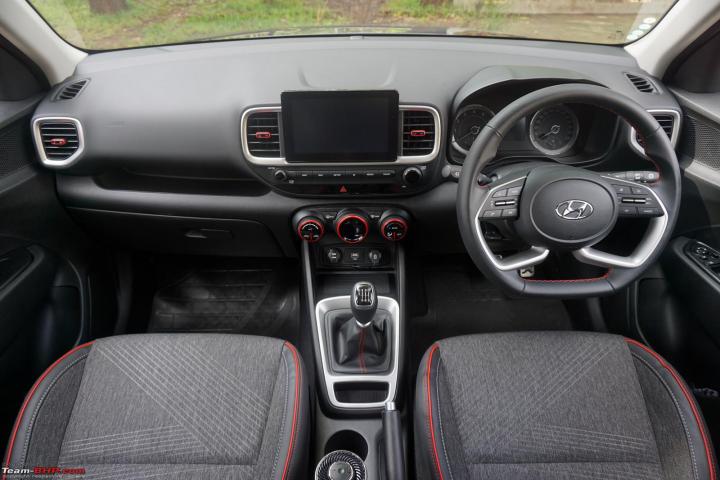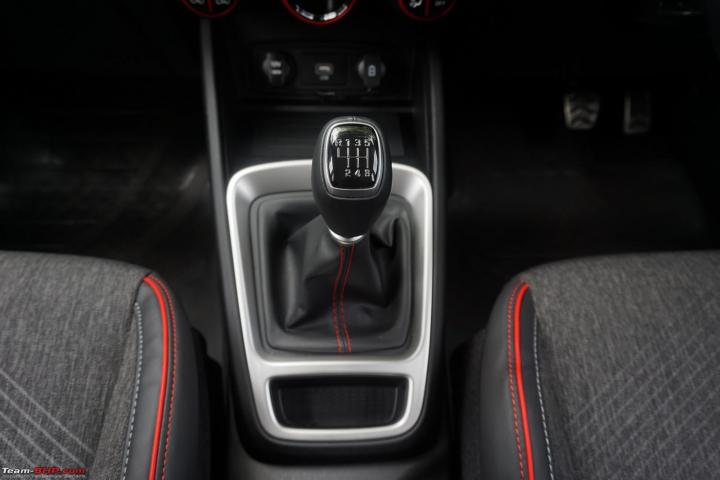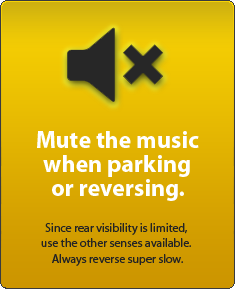News
New Hyundai Venue IMT: 39 observations after 4 hours driving
31st August 2020, 11:00 by Kanad Kalasur
Hyundai offers the widest range of engines & gearboxes in India - an earlier Team-BHP article lists them all. Among ATs alone, Hyundai has a wide variety of traditional torque-converters, smooth CVTs, high-tech DCTs and the least-jerky AMTs in India. Technologically-challenged Maruti-Suzuki can only dream about such a wide portfolio of drivetrains. As if that wasn't enough, Hyundai has added another gearbox to the line-up = this unique 6-speed Intelligent Manual Transmission (IMT). Aditya got to drive the IMT for 4 hours and here are his quick & brief observations.
• I cannot think of a single car that offers more gearbox options with one engine than the Venue. In its segment, the Venue also has the most number of engine + gearbox combinations.
• The IMT variants are priced between Rs. 9,90,990 - 11,25,900. Translated, the IMTs have a premium of just Rs. 15,990 - 23,500 over their equivalent manual variants. That makes them pretty good value for money. The price you pay is barely anything for freeing yourself from the hassle of pressing a clutch pedal continuously in traffic. On the other hand, the DCT variants cost between Rs. 1,14,000 - 1,62,000 more than their equivalent manual variants. The usual premium for the conventional torque-converter ATs is ~1 lakh across manufacturers.
• Your first & most obvious question will be "why don't I just pay another 20,000 rupees and get an AMT?". Good question which has a simple answer. If an AMT's jerkiness is at level 10 out of 10, the IMT is 2 out of 10. For most of us, the AMT's jerkiness & "head nod" are deal-breakers. It must be noted though that Hyundai's AMTs are smoother than Maruti & Tata AMTs because Hyundai uses electronic actuators.
• Who should buy an IMT? Anyone who is on a budget and hates operating the clutch pedal in traffic. Also an ideal option for AMT-haters (due to jerkiness), convenience-seekers, newbie drivers & chauffeur-driven owners (no chauffeur ruining your clutch or giving you jerks).
• Who should NOT buy an IMT? Anyone who has the budget for superior torque-converter, dual clutch or CVT gearboxes. Pure enthusiasts who enjoy fast-shifting MTs & those who are very particular about how slickly their ATs operate. Sporty drivers who want sporty ATs.
• The IMT is not an automatic transmission. It is not even an automated manual transmission (AMT). It is simply a manual transmission without a clutch pedal. It involves shifting a gear lever manually to perform gear changes, like in a regular MT car, but there is no clutch pedal. Instead of your left leg, actuators control the clutch operation, while the driver just shifts the gears.
• To crank the engine, you have to keep the brake pedal pressed and hit the starter button. You have to also ensure that the gear lever is in neutral position. If either of these requirements is not met, the engine enters accessory or ignition-on modes.
• At idle, you can barely hear the engine, but you can feel a buzz on the gear lever if you touch it. On the move too, there is a slight buzz on the gear lever and pedals, but overall, the refinement is impressive.
• Standing still, the engine revs till 5,000 rpm.
• The car can set off in 1st, 2nd or reverse gears. It won't move off in any other gear. The MID will prompt you to shift down if you try to do so in a higher gear. A series of continuous warning beeps will also be heard. The engine does not stall, no matter what you do. Just like in an MT, we will recommend starting off in 1st in the IMT, for a healthy clutch life (2nd gear starts entail some clutch slipping).
• In the city, the IMT is wonderful to use once you get used to it. The left foot is idle and the lesser effort required in driving means you won’t get tired (especially in city traffic). That said, the IMT has a learning curve & required adjustment period because all of us have driven MTs & ATs before, but never a clutch pedal-less MT. It will take your brain a couple of km & time to get familiar with this 2-pedal MT. I got used to driving the IMT in 10 minutes itself, but in certain situations, I did find myself getting confused even after 90 minutes of driving. New owners, give it 2 - 3 days to fully understand the unique arrangement.
• The car can set off even without accelerator input in 1st or 2nd gears. The Venue IMT crawls at 7 km/h and 14 km/h respectively in 1st and 2nd. This crawling is a big boon in bumper-to-bumper traffic as you can effectively drive with just 1 pedal (i.e. the brake).
• Gear shifts are slightly notchy, but the gates are well-defined and the gearbox is sure-slotting.
• The speed of upshifts is normal, but nowhere as fast as a quick-shifting BHPian can manage. In the same breath, we will add that the upshift speed is comparable to what your non-petrolhead spouses, siblings & friends deliver.
• No clutch pedal to press makes your work easier. There is no stalling problem and no jerk felt as the driver does not have to release a clutch. In fact, we will say that the IMT is smoother than some inexperienced or rash MT drivers.
• There is no jerkiness like the AMT gearbox while gears are changed. It's much smoother in comparison. We have to again add that if an AMT is 10/10 in jerkiness levels, the IMT is a "2".
• Conventional automatics and AMTs change gears on their own if the revvs are too high or low. In the IMT, that is not the case. Only the driver can change gears. If the revs drop too low, the clutch will engage to prevent stalling. If the revs are too high, the IMT will maintain max rpm (like in an MT).
• You need not take your foot off the accelerator while changing gears. That said, if you do lift off, the transition (to the next gear) is slightly smoother. We anyway take our foot off the accelerator while shifting gears in an MT, so this will be a good habit to develop.
• Turbo lag, if any, is masked well by the transmission. Power delivery is linear and driveability is very good.
• The MID will warn you (along with continuous beeps) if the revs are too low and ask you to shift down. It will also warn you if you shift up too early (under ~1,000 rpm). This is to prevent any lugging of the engine.
• If you shift up too early, the engine will not complain or knock. But, there is just no power coming through. On one instance, the car pulled from under 1,000 rpm in 3rd gear, but progress was too slow. What if you mischievously shift from 1st to 6th at 10 km/h? No power = the clutch will not engage (for the sake of driveability & clutch life).
• If you need to close gaps in traffic, you will need to shift down and keep the engine in its power band (or close to the power band).
• In case you stop at a signal in anything above 2nd gear, the MID warns you (again, with continuous beeping), requesting you to downshift.
• The car can comfortably cruise at 40 km/h in 3rd gear with the engine spinning at ~1,750 rpm.
• The lack of a clutch pedal will initially confuse the best of us. You put it in one gear and keep going...sometimes forgetting it is not an automatic and that you have to shift gears! The increasing engine sound reminds you to shift up. There is a learning curve; some drivers will adapt to it faster than others.
• The dead pedal is wonderfully positioned & the ergonomics are spot on. All these points make the car very easy and smooth to drive in the city (particularly in stop-go traffic).
• On the highway, the IMT is an excellent cruiser. Mid-range performance is strong and most of the time, there is enough power and torque to make good progress.
• Further to the previous point, Hyundai has wisely introduced the IMT with a powerful petrol engine. In our opinion, they should soon introduce the IMT with the diesel too. The tractable diesel will be well-suited to the IMT. Diesel ATs are usually the most expensive combination, so a Diesel IMT might be a popular choice.
• Because you can’t use higher gears at low rpms (without the system warning you like crazy & the terribly slow progress, if at all), you'll inevitably be in the right gear most of the time. This way, you are always in the power band (or close to it), and there will be no problem of turbo lag.
• The engine revs till ~6,600 rpm after which, the rpm limiter kicks in abruptly. This can sometimes catch you out in the middle of an overtaking maneuver & you will have to quickly upshift. If you don't, the engine will maintain max revs. In case you were curious, the Venue IMT will touch 50 km/h in 1st gear and 90 km/h in 2nd.
• In 6th gear, the car sees 100 km/h @ ~ 2,250 rpm and 120 km/h @ ~2,750 rpm.
• It is only when you get aggressive with the car that a proper manual and clutch pedal are missed. The actuator disengages in a more relaxed, calmer manner than a manually-operated clutch. This also means that the 0 - 100 acceleration isn't as fast as an MT. If you are a hard-driving enthusiast who likes to zoom on the open road, a pure 3-pedal MT or fast AT are the recommended choices.
• A driver can downshift at any time. The IMT matches the engine revvs on downshifting.
• A healthy amount of engine braking is available and this gives the driver a feel of good control.
• On a slope, put the car in 1st gear, release the brake and it will instantly move forward without any rollback. It works identically in reverse gear as well. Why? Because the Venue SX(O) that I drove has the "hill hold" feature. I am very apprehensive about how an IMT without hill-hold will handle slopes - this is a situation that AMTs also suck at. If you buy an IMT without hill-hold, we are pretty sure you will have to use the handbrake judiciously (just like in an AMT). Not doing so will stress out the clutch.
• In summary, we have to say that Hyundai has introduced a properly-engineered IMT, and not a half-baked one. This is a well thought-out gearbox option. We had also seen the same with their AMT which used electronic actuators & was the smoothest in the market (Maruti, Tata & others use hydraulic actuators in their jerky AMTs).
• Admittedly, we were unsure about the point of this kind of gearbox when we heard about Hyundai offering it. After driving the IMT, we aren't anymore. It's a good option for the cost-conscious customer.
• Long-term reliability & maintenance are big unknowns. We will wait for BHPian ownership reports to pass the final verdict on that. The flawed AMT has had many complaints (related Team-BHP search).
• This is surely an experiment; Hyundai as well as other car brands are closely watching the market's response. If enough customers bite, you can be sure that more cars will get the IMT. VW popularized dual-clutch ATs in India, Maruti did the same with AMTs and now, its Hyundai’s turn with the IMT. We are happy to see this kind of a cost-effective innovation in our price-sensitive market. We think that the IMT has potential in the <10 lakh price segment, but certainly not over it.
- Tags:
- Indian
- Hyundai
- Launches & Updates
- Venue
- IMT

















_2.jpg)

.jpg)





